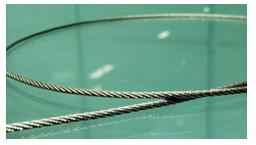In today’s blog we are going to be looking at some of the questions we commonly receive here at Loos Medical Technologies Division. Some recent questions we have received are in relation to Gigli saws. Check them out below!
Q: Are Gigli & Bone Saws the Same Thing?
A: Yes! Gigli saws are commonly referred to as bone saws. The medical instrument is relatively simple but it is very important. The saws allow surgeons to perform amputations and have been used in the industry for over 100 years.
Q: How are Bone Saws Made?
A: The saws are made of just a few small metal components. The reason being that it is a manual hand tool which relies on human strength and friction. The metal parts are required to be strong in order to quickly cut through bones and tissue.
Q: What Type of Metal Should be Used in Bone Saws?
A: The tools are traditionally made with stainless steel wire. The main reason being that stainless steel has extreme strength properties, alongside excellent corrosion resistance. Many other types of metal would simply not be able to perform the
Q: How Many Handles Does a Bone Saw Have?
A: Typically, the saws have two handles. It is important to note that the blade on the tool is also extremely flexible.
Q: What Makes the Blade so Effective?
A: The blade is made with a thin collection of stainless steel wires that are methodically twisted into barbs. The barbs allow for cutting surfaces along all edges and sides. Each end of the blade is then finished with a loop, engineered to accept the various sizes of detachable handles. During an amputation, the surgeons will pull back and forth on each handle. Depending on the level needed, the surgeons will apply varying amounts of pressure and speed to generate sawing motions. What makes the saw unique is that the twisted wires simulate a serrated blade with 360 degrees of flexible cutting surface. The flexible cutting and sharp teeth makes quick work of removals.
Q: Why Are Modern Power Tools Not Used for Amputation?
A: Modern power tools are actually used for amputations. Modern power tools have replaced manual saws as the primary tool for amputation, however bone saws are still used during detailed procedures where precision and control are required. They allow for smooth, even cutting, especially in small or sensitive areas. Bone saws are still regularly used for limb removal and bone extraction.

Now that we have provided some answers to the common questions we receive about bone saws, it is important you choose a source for your blade wire that will achieve the highest level of performance. With a variety of different stainless steel grades, we have the material and expertise required to produce the highest quality wire available in the medical market. Our experience drawing and stranding complex materials, sizes, and tolerances ensures each product is carefully produced to meet each customer’s unique specifications.
To learn all about our 302, 304V, and 316LVM stainless steel wire, visit the materials page in our resource library. For more information about Gigli bone saws and our other common surgical instruments, visit our surgical instruments page here. Alternatively, if you have any other questions our team is here to help! You can reach out to us by email at sales@loosco.com or by phone at (800) 533-5667.
